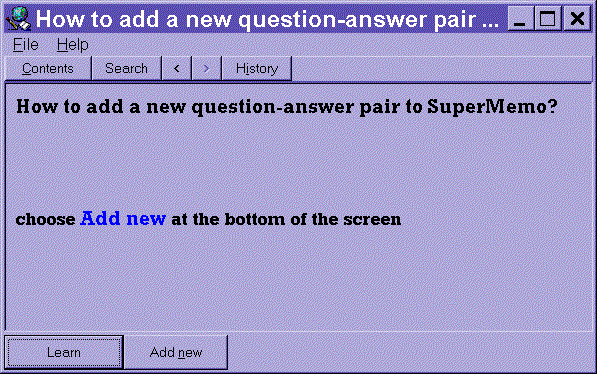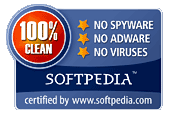SuperMemo 98 for Windows is a program for computer-assisted learning. It uses a number technologies that make the learning process more effective. It can be used by individual students or by authors of learning material. It is mostly designed for self-instruction but it also provides all authoring features needed to develop attractive and effective interactive hypermedia courseware and presentations. It can help you (or your students) remember whatever you think is worth remembering. In the beginner mode, you only need to know two operations: Add new (adding new learning material) and Learn (memorizing and rehearsing the material)
Most important technologies used in SuperMemo 98
- repetition spacing - SuperMemo 98 implements repetition spacing, a modern speed-learning method based on computing optimum intervals between repetitions. This method greatly increases the speed of learning new material and practically eliminates the problem of forgetting. This technology is proprietary to SuperMemo World and has been the key to the success of SuperMemo over the last eight years
- active recall - SuperMemo 98 makes it easy to properly represent material used in learning and helps the user to create simple quiz elements based on active recall. For example, question-and-answer pairs, spelling tests, pronunciation tests, drag-and-drop tests, point-and-click tests, multiple choice tests, mind maps, programmed learning procedures, and many more
- mnemonic hypermedia - SuperMemo 98 combines all popular computer data formats such as HTML, graphics, sound, animation, video, etc. These formats are enhanced by programmability with interpreted scripts and binary components developed for procedural learning (EXE or DLL). All elements taking part in learning are placed in a tree structure called the knowledge tree that simplifies the knowledge access and navigation (picture). All components, including text, sounds, graphics, etc. can be hyperlinked with other parts of the learned material
- linear and selective learning modes - learning can proceed in the sequence programmed by the author of the course or in the sequence chosen by the student (e.g. pick-and-learn mode, find-and-learn mode, random learning, etc.).
- dual knowledge representation approach - there is a strict division between knowledge that is used for learning, and knowledge that is used for rehearsing the learned material. In addition, knowledge used only as reference or comment can also be included in the learning material
- processing attributes - all portions of material used in learning are clearly marked as: (1) reference material, (2) unprocessed learning material (sorted for learning priority), (3) processed material (sorted for the priority of rehearsal). The program provides rich statistics that illustrate the student's progress in processing individual sections of the material
General steps in using SuperMemo 98
- the student or the author creates collections of pages containing the learned material. It the simplest case, these are just questions and answers; however, these pages can also include graphics, video, special exercises, reference material, executable modules, hyperlinks, mind maps, OLE objects, and many more
- (optionally) the author builds knowledge tree by organizing all pages into a tree structure (this tree can also be used to automatically generate the learning scenario)
- (optionally) if there is a larger group of students or customers, the teacher or students themselves create a subset copy of the learning system for individual use by each student (including learning statistics, editable material, individual comments and annotations, etc.). An alternative solution is to replicate the learning material on CD-ROM media
- the student proceeds with learning. The program is able to hide the authoring shell behind the learned course. This way, the student can practically go through the entire course by knowing only the button Learn
Note: there is no compilation stage before releasing a CD-ROM course in SuperMemo 98. Indeed, the author can give the students a free hand to expand and/or improve upon the learning material!
Important! SuperMemo 98 is ideally suited for self-learning. All complexities of the program can be circumvented by choosing only two options: (1) Add new which adds a new question-answer pair to the collection, and (2) Learn which rehearses the introduced material. Indeed, this mode has made SuperMemo the most popular software ever developed in Poland. See: ABC of SuperMemo 98

Figure 1. SuperMemo in the beginner mode can be mastered in minutes |
Most prominent features implemented in SuperMemo 98
- Standard features of SuperMemo also found in earlier
implementations:
- possibility of creating independently named bodies of learning material: so-called collections
- repetition spacing algorithm, widely known as the SuperMemo method, used in computing optimum intervals between repetitions in the process of learning
- comprehensive statistics for supervising the learning process including: daily and monthly calendar of repetitions, average number of items to repeat per day, average repetition time, expected number of future repetitions, difficulty distributions, inter-repetition interval distributions, etc.
- tools for managing the learning process such as: selective memorizing and resetting individual elements, rescheduling outstanding repetitions, etc.
- element browsers (for browsing memorized items, difficult items, item subsets, items selected by an item filter, etc.)
- element editing tools such as clipboard operations, duplicating elements, etc.
- collection file management tools such as Copy, Delete, Move, Transfer, Export, Import, etc.
- fast searching for text substrings, search-and-replace, etc.
- recovery procedure for rescuing corrupted files
- Features of SuperMemo 98 not found in SuperMemo 7:
- modern interface (MDI, toolbars, tabbed notebooks, pop-up menus, hints, Question of the Day on start-up, context-sensitive help, configurability, configuration auto-save, etc.)
- hypermedia (sound, graphics, animation, video, HTML, scripting, binary components, etc.) and all tools for composing learning elements and changing properties of individual components (e.g. hyperlinks, registry associations, color, font, size, alignment, sound, video subsections, scripts, and many more)
- standard navigation tools (Contents, Search, Back, Forward, History, etc.)
- knowledge that can be organized in a knowledge tree. A number of tools can be used to operate only on selected branches of the knowledge tree
- maintaining objects registries with fast access to all objects in the system such as: texts, words, image files, fonts, scripts, OLE objects, programs, translation strings, transcriptions, HTML files, etc. including access to all elements that use particular objects. All registries, including the full lexicon are updated on-the-fly (i.e. there is no separate build operation). Registries are editable
- possibility of hiding the authoring shell of SuperMemo behind the learning material (this exposes the student to the simplest interface possible). Including read-only and learn-only modes in addition to the full-access mode
- practically unlimited number of elements that can be stored in the learning material
- tools for easily releasing courseware and presentations on CD-ROM (including a separately available, favorable license for SuperMemo 98 itself)
- greatly improved repetition spacing algorithm (also licensable for software developers as a separate DLL module)
- export and import of the learning process alone
- Novel features of SuperMemo 98 not found in SuperMemo 8:
- faster 32-bit application supporting long filenames
- unlimited length of texts
- RTF support
- HTML support
- OLE support
- transparent texts and images
- background images in the element window
- three levels of complexity: beginner, basic, and professional (to make SuperMemo yet easier at the entry level)
- selectable interface font
- in-built simulation of the learning process
- automatic final drill scrambling
- Question of the Day
- for more see: What's new in SuperMemo 98
- Specialist features in SuperMemo 98:
- programmability (learning collections can be extended by scripts and programmed components written in any programming language)
- user-defined degree of attention given to individual elements or entire branches in knowledge tree. By changing the so-called forgetting index, the probability of forgetting for all individual elements can be controlled!
- element templates used for quick creating of a large number of pages designed along the same style
- interactive translation of the entire course to other languages (the translation strings are kept in a translation registry like all other objects in the system)
- translation of the program's interface to other language (note that only simple interface in Beginner and Basic modes is subject to translation)
- customizable sound feedback in learning
- tools for creating lexical word-pair collections associated with a given course
- random learning and random review in the entire collection of elements, in browsers and in registries
- great number of new statistical parameters documenting the progress of learning
- debugging version makes it easier to spot bugs in the collection
- and many more
Further reading:
- Download SuperMemo 98 Freeware
- What's new in SuperMemo 98
- History of SuperMemo 8 Development
- ABC of SuperMemo - see how simple it is at the entry level!
- SuperMemo beta-testing programs: SuperMemo 8.2 (Spring 1997), SuperMemo 8.4 (Fall 1997), SuperMemo 98 (Summer 1998)
- Certified as free from malware by Softpedia (Mar 2006)


